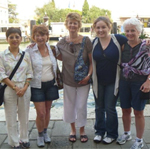
Many of Italy’s finest works of art are in its architecture. Discovering the history of its origins and the fascinating evolution of its styles, will open up an entirely new world as you tour through the intoxicating landscape.
To study the architects of Italian life, from early Roman civilization to the breathtaking style of today is to study the art of living. With its vast array of architectural designs, a day-long tour of Rome is not enough. The reason? The variety of style in Italian architecture is is such that it can be classified not just by chronological period, but also by region.
From the earliest times, the Romans were stimulated by ideas from Greece, then began to develop their own authentic architectural styles and designs. Look closely as you make your way around the ancient ruins of the Roman era for signs of this adaptation from the Greek influence in some well known Roman structures.
Much of Italy’s history can be seen in its architectural timeline. Around AD 313 structures built in the country represented the trappings of victory, money and power. They were made of bricks and marble. The known arch of Constantine in Rome was built during this era and is considered to depict arches of triumph. Domes became more common in the country’s buildings around AD 800. The emergence of Romanesque designs came during the middle ages, more specifically during the mid-9th century. It was during this period that the round arches and simple plans of the Roman Basilicas became popular.
It was during this time too that Italian architecture began to make a significant architectural impression across the rest of the world. As this occurred, the Roman style became the dominant fashion for churches and public buildings across the entire continent of Europe, inspiring a generation of buildings with rounded arches and carved portals.
Later, during the 14th-century the reawakening of the Italian Renaissance began to flourish. This change was to have a significant effect on the more recent of structures of today. The Renaissance style originated in the artistic, architectural, cultural, political and social movements of Tuscany.
An architectural tour of Italy becomes more interesting with a visit to the impressive Mole Antonelliana in the city of Turin. Constructed during modern times (between 1863 and 1869), Mole Antonelliana was then the tallest building in the whole world and is renowned for its towering granite spire. During this era too, the new skyscrapers like the stunning Torre Velasca were built. One of the finest examples of modernist architecture is the Pirelli Tower which also dominates the skyline of Milan.
There are about 100,000 documented monuments of all varieties spread across Italy. Amongst them are palaces, statues, churches, archaeological remains, museums, buildings, fountains, villas and historic houses.
The Great Italian architectural structures include the Colosseum, Duomo of Milan, building designs in Venice and the Santa Maria del Fiore Cathedral in Florence which is a masterpiece of Italian architecture has the largest brick dome in the world.
If you love the architecture of Italy, you’ll understand why it isn’t just an inspiration to those who live in this fascinating country amongst it. Wherever you look in the world, there is evidence of its having inspired works influenced the style of more modern structures in almost every culture.
Touring Italy for its architecture will satisfy every traveler with a thirst for a genuinely outstanding architectural experience.










